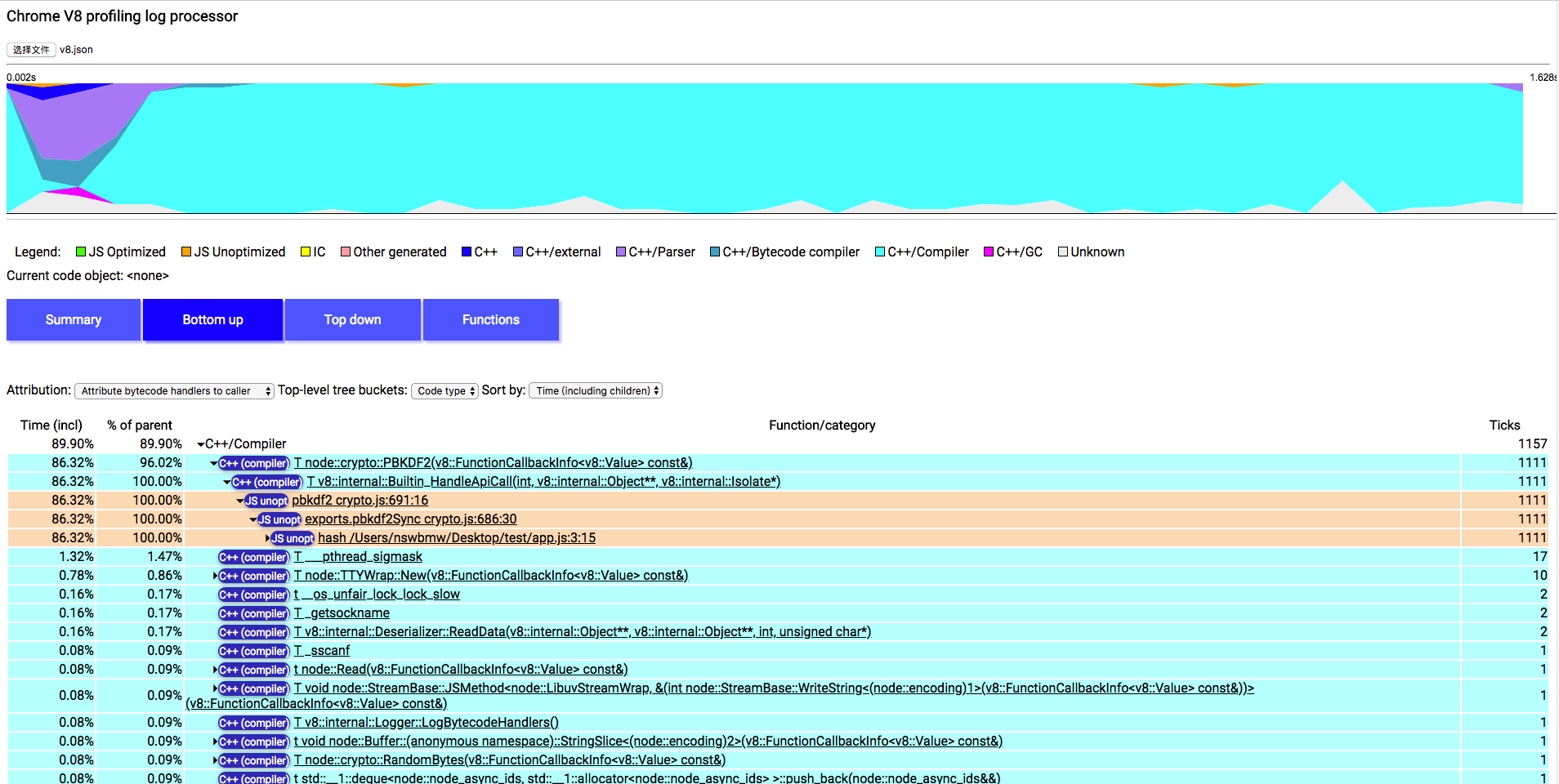V8 内置了一个性能分析工具——Tick Processor,可以记录 JavaScript/C/C++ 代码的堆栈信息,该功能默认是关闭的,可以通过添加命令行参数 --prof 开启。
1.3.1 Tick Processor
创建测试代码:
app.js
const crypto = require('crypto')
function hash (password) {
const salt = crypto.randomBytes(128).toString('base64')
const hash = crypto.pbkdf2Sync(password, salt, 10000, 64, 'sha512')
return hash
}
console.time('pbkdf2Sync')
for (let i = 0; i < 100; i++) {
hash('random_password')
}
console.timeEnd('pbkdf2Sync')
运行:
$ node --prof app
pbkdf2Sync: 1375.582ms
可以看出,执行 100 次 hash 函数总共用了 1375.585ms,并且当前目录下多了一个 isolate-xxx-v8.log 文件,该文件记录了 V8 的性能日志,内容如下:
v8-version,6,1,534,50,0
shared-library,"/usr/local/bin/node",0x100001800,0x100bbb69a,0
...
code-creation,Function,18,111912,0x37d07c7246a8,144,"hash /Users/nswbmw/Desktop/test/app.js:3:15",0x37d07c7076d0,~
code-creation,LazyCompile,18,111927,0x37d07c7246a8,144,"hash /Users/nswbmw/Desktop/test/app.js:3:15",0x37d07c7076d0,~
code-creation,Function,18,112058,0x37d07c725690,80,"exports.pbkdf2Sync crypto.js:686:30",0x37d07c70cb58,~
code-creation,LazyCompile,18,112074,0x37d07c725690,80,"exports.pbkdf2Sync crypto.js:686:30",0x37d07c70cb58,~
...
早期我们需要借助 node-tick-processor 这样的工具解析 v8.log,但 Node.js 在 v5.2.0 之后包含了 v8.log 处理器,添加命令行参数 --prof-process 开启。
运行:
$ node --prof-process isolate-0x103000000-v8.log
结果如下:
Statistical profiling result from isolate-0x103000000-v8.log, (1152 ticks, 44 unaccounted, 0 excluded).
[Shared libraries]:
ticks total nonlib name
[JavaScript]:
ticks total nonlib name
1 0.1% 0.1% Function: ~Uint8Array native typedarray.js:158:31
1 0.1% 0.1% Function: ~NativeModule.cache bootstrap_node.js:604:42
1 0.1% 0.1% Function: ~Buffer.toString buffer.js:609:37
[C++]:
ticks total nonlib name
1023 88.8% 88.8% T node::crypto::PBKDF2(v8::FunctionCallbackInfo<v8::Value> const&)
27 2.3% 2.3% t node::(anonymous namespace)::ContextifyScript::New(v8::FunctionCallbackInfo<v8::Value> const&)
...
[Summary]:
ticks total nonlib name
3 0.3% 0.3% JavaScript
1105 95.9% 95.9% C++
3 0.3% 0.3% GC
0 0.0% Shared libraries
44 3.8% Unaccounted
[C++ entry points]:
ticks cpp total name
1062 98.2% 92.2% T v8::internal::Builtin_HandleApiCall(int, v8::internal::Object**, v8::internal::Isolate*)
13 1.2% 1.1% T v8::internal::Runtime_CompileLazy(int, v8::internal::Object**, v8::internal::Isolate*)
...
[Bottom up (heavy) profile]:
Note: percentage shows a share of a particular caller in the total
amount of its parent calls.
Callers occupying less than 1.0% are not shown.
ticks parent name
1023 88.8% T node::crypto::PBKDF2(v8::FunctionCallbackInfo<v8::Value> const&)
1023 100.0% T v8::internal::Builtin_HandleApiCall(int, v8::internal::Object**, v8::internal::Isolate*)
1023 100.0% Function: ~pbkdf2 crypto.js:691:16
1023 100.0% Function: ~exports.pbkdf2Sync crypto.js:686:30
1023 100.0% Function: ~hash /Users/nswbmw/Desktop/test/app.js:3:15
1023 100.0% Function: ~<anonymous> /Users/nswbmw/Desktop/test/app.js:1:11
...
打印结果包含六部分:Shared libraries、JavaScript、C++、Summary、C++ entry points 和 Bottom up (heavy) profile。[JavaScript] 部分列出了 JavaScript 代码执行所占用的 CPU ticks(CPU 时钟周期),[C++] 部分列出了 C++ 代码执行所占用的 CPU ticks,[Summary] 列出了各个部分的占比,[Bottom up] 列出了所有 CPU 占用时间从大到小的函数及堆栈信息,小于 1% 的则不予显示。
可以看出:88.8%的 CPU 时间都花在了 crypto.js 文件的 pbkdf2Sync 函数上,该函数在 app.js 第 3 行被调用,即我们的 hash 函数。
解决方法:将同步的 pbkdf2Sync 改为异步的 pbkdf2。修改代码如下:
const crypto = require('crypto')
function hash (password, cb) {
const salt = crypto.randomBytes(128).toString('base64')
crypto.pbkdf2(password, salt, 10000, 64, 'sha512', cb)
}
let count = 0
console.time('pbkdf2')
for (let i = 0; i < 100; i++) {
hash('random_password', () => {
count++
if (count === 100) {
console.timeEnd('pbkdf2')
}
})
}
运行结果:
$ node --prof app
pbkdf2: 656.332ms
可以看出,程序运行了 656.332ms,相比较于之前的 1375.585ms,性能提升了 1 倍。我们继续看下 v8.log 的分析结果,运行:
$ node --prof-process isolate-0x102802400-v8.log
Statistical profiling result from isolate-0x103001a00-v8.log, (198 ticks, 19 unaccounted, 0 excluded).
[Shared libraries]:
ticks total nonlib name
[JavaScript]:
ticks total nonlib name
1 0.5% 0.5% StoreIC: A store IC from the snapshot
1 0.5% 0.5% Function: ~set native collection.js:149:4
1 0.5% 0.5% Function: ~pbkdf2 crypto.js:691:16
1 0.5% 0.5% Function: ~inherits util.js:962:18
1 0.5% 0.5% Builtin: ArrayIteratorPrototypeNext
[C++]:
ticks total nonlib name
83 41.9% 41.9% T ___kdebug_trace_string
31 15.7% 15.7% t node::(anonymous namespace)::ContextifyScript::New(v8::FunctionCallbackInfo<v8::Value> const&)
14 7.1% 7.1% T ___pthread_sigmask
...
[Summary]:
ticks total nonlib name
5 2.5% 2.5% JavaScript
174 87.9% 87.9% C++
3 1.5% 1.5% GC
0 0.0% Shared libraries
19 9.6% Unaccounted
[C++ entry points]:
ticks cpp total name
41 60.3% 20.7% T v8::internal::Builtin_HandleApiCall(int, v8::internal::Object**, v8::internal::Isolate*)
17 25.0% 8.6% T v8::internal::Runtime_CompileLazy(int, v8::internal::Object**, v8::internal::Isolate*)
...
[Bottom up (heavy) profile]:
Note: percentage shows a share of a particular caller in the total
amount of its parent calls.
Callers occupying less than 1.0% are not shown.
ticks parent name
83 41.9% T ___kdebug_trace_string
31 15.7% t node::(anonymous namespace)::ContextifyScript::New(v8::FunctionCallbackInfo<v8::Value> const&)
31 100.0% T v8::internal::Builtin_HandleApiCall(int, v8::internal::Object**, v8::internal::Isolate*)
31 100.0% Function: ~runInThisContext bootstrap_node.js:495:28
31 100.0% Function: ~NativeModule.compile bootstrap_node.js:584:44
31 100.0% Function: ~NativeModule.require bootstrap_node.js:516:34
...
可以看出,[Bottom up] 没有很多 ticks,而且不再有 pbkdf2 这种堆栈信息。
1.3.2 Web UI
V8 还提供了一个 Web 可视化工具来查看生成的 v8 日志。首先,将代码还原到使用 pbkdf2Sync 的版本,运行:
$ node --prof app # 生成 isolate-0x103000000-v8.log
$ node --prof-process --preprocess isolate-0x103000000-v8.log > v8.json # 格式化成 JSON 文件
$ git clone https://github.com/v8/v8.git # 克隆 v8 仓库
$ open v8/tools/profview/index.html # 打开 V8 profiling log processor
点击 “选择文件”,选择刚才生成的 v8.json 文件,点击 “Bottom up” 视图,如下所示:

有以下两点需要解释:
- 图中的上半部分展示了 CPU 的 timeline,X 轴代表时间的流逝,Y 轴代表当前时间点不同部分占用 CPU 的比例,可以在 timeline 图表上单击左键不放,然后拖动,选择时间区间。
- 图中的下半部分展示了当前时间段内 CPU 占用比从大到小降序排列的函数,展开可查看堆栈信息。不同的颜色代表了不同的部分,点击任意一个函数,timeline 底部会展示该函数的执行时间分布。
1.3.3 参考链接
- https://github.com/v8/v8/wiki/V8-Profiler
- https://blog.ghaiklor.com/profiling-nodejs-applications-1609b77afe4e
- https://stackoverflow.com/questions/23934451/how-to-read-nodejs-internal-profiler-tick-processor-output
上一节:1.2 v8-profiler